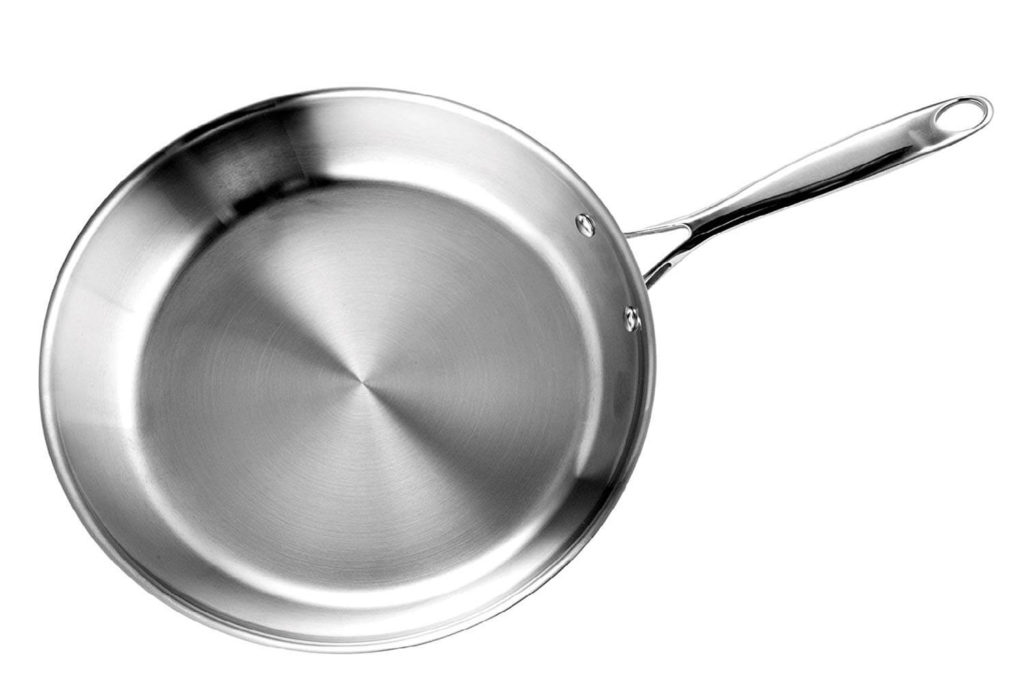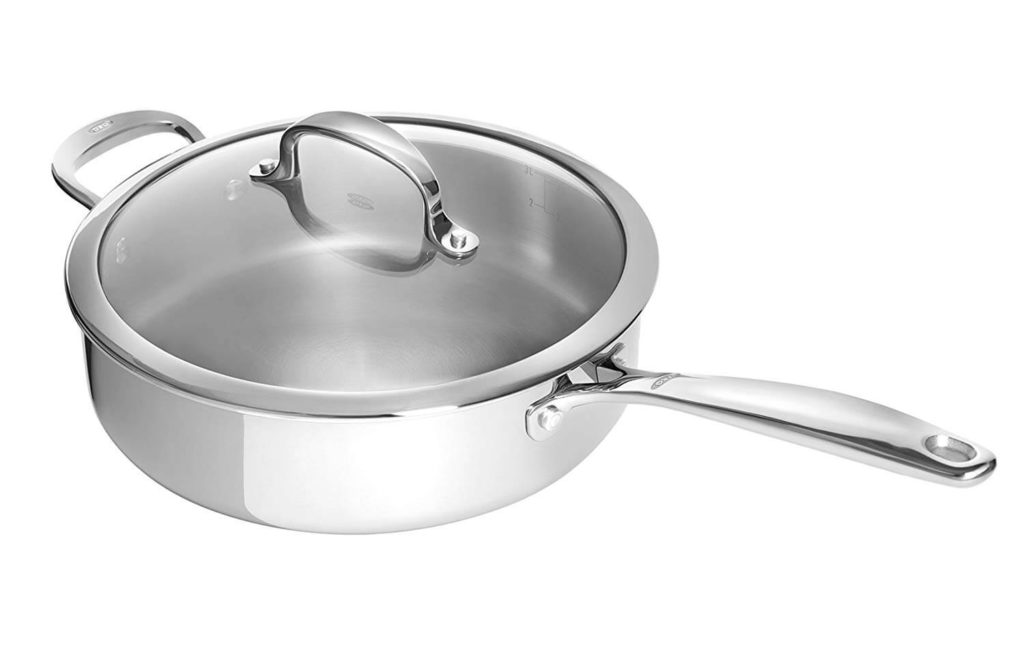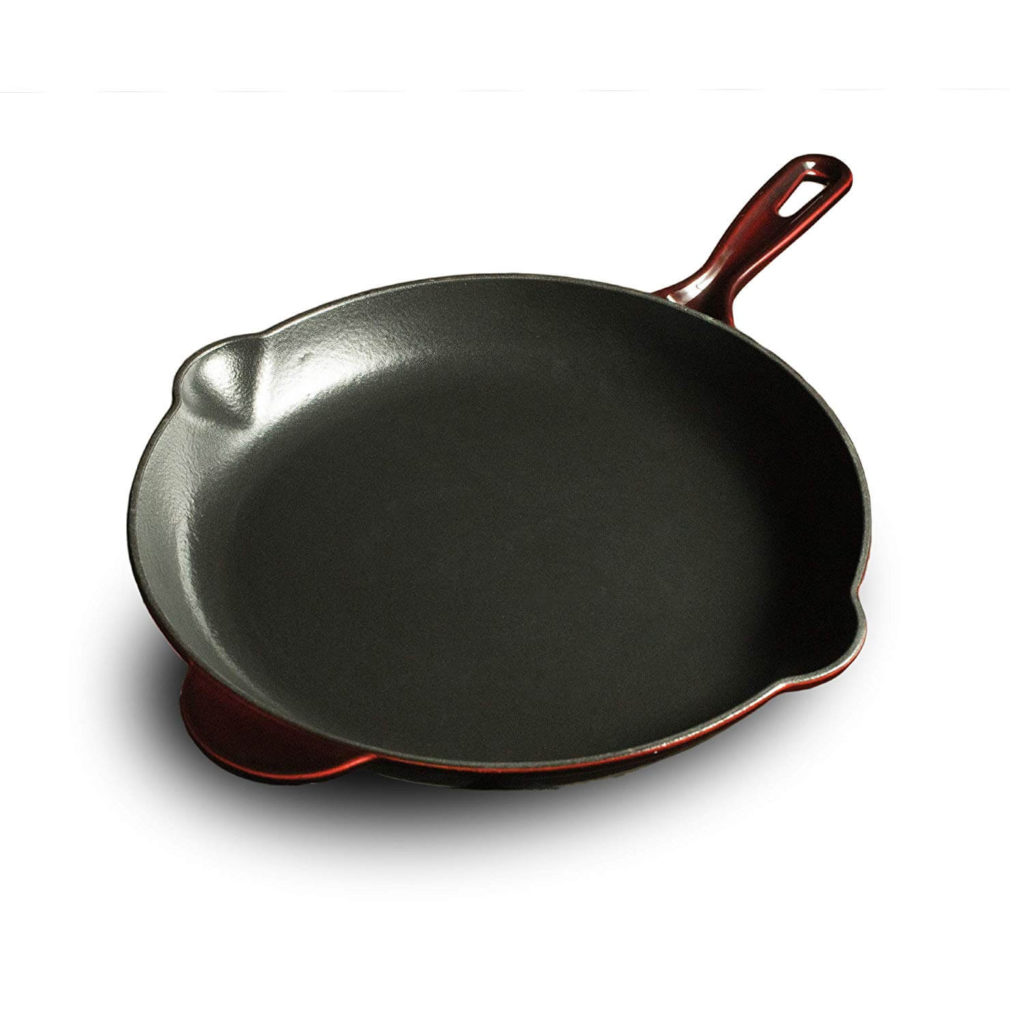As my mom always used to say to me, if you buy cheap then you buy twice and she was right! There is nothing more frustrating than putting a lot of hard work, sweat and tears into a meal, only for it to become burnt or not cook properly due to inferior cooking equipment.
Not only does having the wrong equipment often mean that your food will stick and burn, but it often means that you end up with bent, stained and badly scratched kitchen cookware which can look rather embarrassing when family or friends come over for dinner.
If you are kitting out a brand new kitchen the best thing to do is to choose Cast Iron vs Stainless Steel – okay so you may have to fork out a little extra for them initially as the best things in life are never free, but you will save money in the long run as quality materials are built to last. Perhaps you are not kitting out a new kitchen, but are looking to replace a rather tired looking kitchen utensil set, then I would still like to encourage you to look into purchasing your cookware in high-quality materials that will be hard-wearing and easier to clean and keep clean.
So you may now be wondering, are there certain cookware materials that I should avoid purchasing? And if so, what are they? The answer is yes – there are certain cookware materials that are cheap, but just do not last. These materials are perfect for just a few uses or to put aside for camping or other one-off uses.
Table of Contents
Cast Iron Vs Stainless Steel in 2020
If you have decided that stainless steel is the cookware for you then you are in the right place as I will go on to review three of what I think are the very best stainless steel cookware frying pans and skillets. Check it out!
Cooks Standard Fry Pan

If you are looking for a new frying pan, you may have been debating: cast iron vs stainless steel skillet – what would be best?
Features
- It has the toughness of stainless steel outside with a great aluminum surface, helping it to distribute heat more evenly.
- It is dishwasher safe making for a speedy cleanup.
- The stainless steel handle stays cool, even when you cook using high temperatures and that combined with how lightweight it is, will make flipping a batch pancakes a dream.
Cooks Standard NC-00239

When choosing cast iron skillet vs stainless steel, here is another instance where stainless steel really excels.
Overview
This 12 inch multi-ply clad frying pan by Cooks is fantastic for the following reasons.
Features
- It is multi clad, the surface being made of aluminum, which helps to spread the heat evenly across the pan, avoiding things from sticking and burning in the middle of the pan.
- The pan measures 12 inches, the perfect size for families to cook various rashers of bacon, a couple of eggs or fry a couple of slices of French toast.
- It works on induction, gas, electric cookers and is also safe to pop in the oven.
OXO Good Grips

There are some great features on this Oxo good grips stainless steel skillet that really help to settle the stainless steel vs nonstick debate.
Features
- It comes with non drip pouring edges which are handy for draining the juices from foods without making a mess.
- The inside has measurement markings that will help you to follow the recipe to a T.
- The stay-cool handles and 3 ply construction make it easier to use, even when cooking at high temperatures, also avoiding the burning and sticking of your food.
If you would prefer cast iron cookware then have a look at the following list of the very best cast iron cookware skillets that are on the market today:
Lodge Skillet

Searching for the best cooking materials isn’t easy, but this Lodge pre-seasoned cast iron skillet settles the cast iron vs nonstick battle.
Features
- This skillet had been pre-seasoned with oils that will only mature in taste with time as you use the skillet.
- It is sturdy and solid, ready for any cooking task. It is also robust enough to be used on campfires, not to mention on the stove or in the oven.
- It comes in a stylish black color that will be the perfect match for both modern and more traditional style kitchens.
Landhaus Skillet

When people think of strong, durable kitchen cookware they often think of steel. But cast iron vs steel, what is better? Have a look at this cast iron skillet by Landhaus and you may be amazed at just how effective steel can be.
Features
- This cast-iron frying pan has a glazed black enamel interior giving it all of the nonstick properties you need to cook your favorite recipes with confidence.
- It can be used on gas, induction, ceramic and electric stovetops, meaning you can start using it straight away in the home.
- The glazed surface doesn’t need to be oiled like many cast iron skillets, making it quicker to clean and easier to keep clean.
GreaterGoods Skillet

Are you fed up with your food sticking and burning and are looking for a really solid and long-lasting cast iron skillet?
Features
- This skillet has been machine etched and polished making the suffice smooth and nonstick.
- This skillet had been pre-seasoned with high-quality layers of cold-pressed, organic flaxseed oil, giving your food an unbeatable rich taste.
- The pour spouts on either side of the skillet have been perfectly molded and designed in order to help you to drain the liquid from food without spilling.
Cookware materials to avoid:
Plastic
Plastic cookware utensils such as spatulas and serving spoons are usually the cheapest option on the market, but often scratch easily, bubble when exposed to high temperatures, warp and stain quickly. If you are looking for a kitchen utensil set that will remain in good nick, then plastic is really a no go.
Hard rubber
Hard rubber utensils are also a cheaper option for purchasing a few kitchen bits and bobs. But unfortunately, hard rubber tends to crack and split over time, fade and easily absorbs colors and smells, making it more difficult to clean and to keep clean. Rubber tools are ideal for those who like to bake from time to time as they are soft and are great for scraping butter and other sticky ingredients.
Teflon
Teflon is a nonstick coating that is applied to kitchen cookware. There has been a lot of research that has gone into Teflon coatings as the coating starts to breakdown when heated to over 300 degrees Celsius, releasing harmful PTFE toxins into the air, so it is best to avoid purchasing Teflon coated cookware as it will be safer for both you and your family.
So now that you have an idea about what materials to avoid, you are most probably wondering what materials are the best to use in the kitchen? The next part of this article has been dedicated to helping you choose between the very best cookware materials and will help you to make a decision on which one to purchase – cast iron or stainless steel.
Have a look at the following information that will really help you to make the best decision.
When is stainless steel cookware best for the job?
If you are looking into purchasing the very best cookware for your kitchen then you will need the most efficient models made out of the highest quality materials. If you have been debating for a while now, stainless steel vs cast iron and are not sure which to choose, then have a look at the following guide which will help you to see why stainless steel cookware would be a great kitchen companion for you.
Stainless steel cookware pros:
Lightweight
Stainless steel is very light, making it easy to cook with, it’s very practical when it comes to flipping foods as it is not too heavy on the wrists, but it is by no means flimsy, rather it is sturdy and perfect for cooking large pots of stew and tough meats.
Easy to clean
The clue is in the name really, stainless steel is easy to wipe down and buff to restore it back to its original shine.
Multiclad
Most stainless steel cookware is multiclad, meaning that it is made up of various metals, which makes it a better conductor of heat, distributing it evenly across food, preventing the frustration of when food is cooked to a crisp in the middle but burnt around the edges.
If you are looking for cookware to flip and make pancakes, fried eggs and omelets then stainless steel will be the best material for you as it is very lightweight. It is also easier to clean than cast iron, meaning that you can spend less time scrubbing pans and longer sitting and enjoying your meal.
Not only that but stainless steel often distributes heat better than cast iron, making it the preferred option if you spend a lot of time making foods that cannot be tampered with while cooking and foods that require even heat distribution such as omelets, pancakes and the like.
When is cast iron cookware best for the job?
So now that you have seen all of the benefits of using stainless steel cookware in the kitchen you are most likely wondering when it would be more convenient to use cast iron cookware and what the pros of cast iron vs stainless steel cookware would be. If so then look no further as the following cast iron cookware guide will help you to see the benefits of cast iron cookware and will help you to decide on which type of cookware will best suit you and your style of cooking.
Cast iron cookware pros:
Sturdy
Cast iron is a lot heavier than stainless steel and cast iron cookware makes heavy duty pots and pans that are great for cooking solid meats and tough cuts of vegetables such as in stews and soups.
Heat retention
Cast iron is great at retaining heat and will keep your food toasty hot as you wait for your guests to arrive.
Versatile
Cast iron can be used on gas and electric stoves, even on most induction stoves making it easier for you to integrate a cast iron pots and pans set into the household without having to go out and purchase all new appliances.
Teflon free
Cast iron doesn’t have a nonstick coating, meaning it is Teflon free or better put, PTFE free, so that you don’t have to worry about harmful chemicals seeping into the air while you are cooking.
If you are looking for a robust and long-lasting cookware set then cast iron will definitely be a great choice. Not only is it solid but it is great at retaining heat, meaning that you won’t have to continue reheating food over and over while waiting for guests to arrive. Cast iron products are also Teflon coating free, making them a healthier option over stainless steel so that you can have real peace of mind when cooking up a storm for the family this weekend.
FAQ
Stainless steel does not tend to corrode or rust as easily as iron does, which is why it a highly durable metal.
A regular stainless steel grill will need new grates and new flavorizer bars in about five years if the grill has been used regularly and well maintained.
If you see rust in the grills, it probably originated from the particles of iron which have collected on the surface of the stainless steel. Therefore, it is these tiny particles that rust and not the stainless steel itself.
Conclusion
If you feel like you still haven’t been able to decide between cast iron vs stainless steel cookware then use the information mentioned above to help you. Consider the specifications that you require in your cookware and make a list of them, carefully considering what you cook most often and how in order to make the very best decision.
Once you have compiled a list of what you expect from your cookware, go back and review the specifications listed above, pausing at each frying pan and skillet that ticks all of the right boxes. Then, when you have narrowed the list down to just two or three candidates, it will be up to your personal preferences as to which you decide on.



Leave a Reply